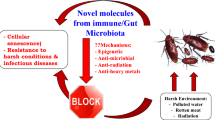Summary
The relationship between Folsomia candida and chitin-degrading microorganisms was studied. On chitin agar, 1010 bacteria were isolated per g faeces, and 3.8×1011 bacteria per g gut contents, 1/3 of them showing a clear (chitin-free) zone around the colony. The most abundant chitin-degrading bacteria were Xanthomonas maltophilia and Curtobacterium sp. To determine the bacterial contribution in the use of chitin by F. candida, a feeding experiment was carried out. F. candida were fed with chitin, either amended with or without tetracycline as an inhibitor of bacteria. When tetracycline was omitted the biomass of F. candida was increased compared to those fed chitin with tetracycline. However, this result was observed only when the food replacement intervals were long enough to allow bacterial colonization before ingestion of the food. In a food-selection experiment, a preference for chitin colonized with microorganisms as opposed to sterile chitin was found. The results indicate that a mutualistic symbiosis of F. candida with chitinolytic microorganisms is likely to enhance chitin degradation. This relationship is not only intra-intestinal but also involves an extra-intestinal phase.
Similar content being viewed by others
References
Anderson JM, Bignell DE (1980) Bacteria in the food, gut contents and faeces of the litter-feeding millipede Glomeris marginata (Villers). Soil Biol Biochem 12:251–254
Bakonyi G (1989) Effects of Folsomia candida (Collembola) on the microbial biomass in a grassland soil. Biol Fertil Soils 7:138–141
Lewis DH (1985) Symbiosis and mutualism: Crisp concepts and soggy semantics. In: Boucher DH (ed) The biology of mutualism. Oxford Univ Press, New York, pp 29–39
Lingappa Y, Lockwood JL (1962) Chitin media for selective isolation and culture of actinomycetes. Phytopathology 52:317–323
Moore JC, Ingham ER, Coleman DC (1987) Inter- and intraspecific feeding selectivity of Folsomia candida (Willem) (Collembola, Isotomidae) on fungi. Biol Fertil Soils 5:6–12
Parle JN (1963) Micro-organisms in the intestines of earthworms. J Gen Microbiol 31:1–11
Wallwork JA (1970) Ecology of soil animals. McGraw-Hill, London
Author information
Authors and Affiliations
Additional information
Dedicated to the late Prof. Dr. W. Kühnelt
Rights and permissions
About this article
Cite this article
Borkott, H., Insam, H. Symbiosis with bacteria enhances the use of chitin by the springtail, Folsomia candida (Collembola). Biol Fertil Soils 9, 126–129 (1990). https://doi.org/10.1007/BF00335794
Received:
Issue Date:
DOI: https://doi.org/10.1007/BF00335794




